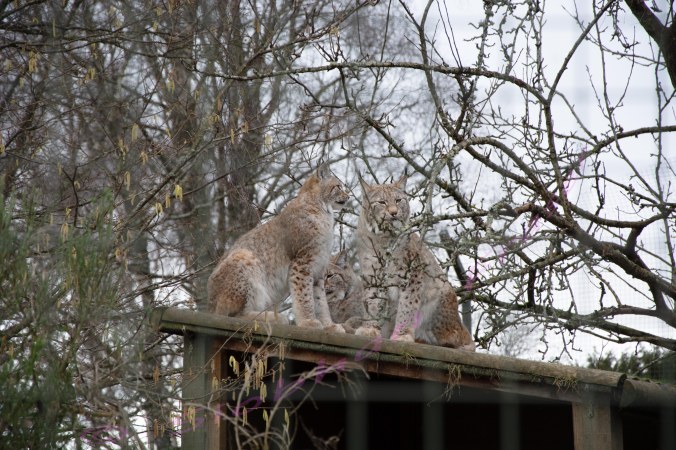One of the animals that enchant me every time I see it at the Highland Wildlife Park (HWP) at Kincraig, is the Eurasian Lynx (Lynx lynx). Why? I think it’s the face and eyes. It has a very wise, ‘old’ face and always leaves me with the feeling that it has read me, and knows every thought I have.
I have been visiting the HWP many times over the years but this week I saw something I haven’t seen before. One of the lynx was up a tree. Just lying, chilling, watching, knowing; up a tree. Why was I surprised, it’s a cat, and that’s what cats do.

In the middle of the picture is a Northern Lynx, sitting in a tree
So do Lynx normally climb trees? In the wild they do and it is quite common for them to cache carcasses in trees. So, it was nice to see natural behaviour from these cats. We’ve also noticed that very often the Lynx at HWP hides in the dense undergrowth of their enclosure. If you look very carefully amongst the bushes you may catch a glimpse of them sleeping. Again, this is very natural behaviour as lynx is mainly nocturnal or crepuscular so tend to spend the day sleeping in dense bushes and shrubs. They also tend to be solitary and secretive animals, except when mothers have kittens.
It’s not until you see a Lynx up close you realise how big they are. The average height of a Lynx is about 65-75 cms and weighs about 15-29 kgs. To put this into perspective, we have a Labrador dog and she weighs about 30 kg and is about 58 cms.

2 Lynx sitting next to each other. One in profile the other facing the camera
In the wild their prey species would include small hoofed mammals (ungulates) eg roe deer or smaller prey like hares.
The lynx has a very wide range which extends throughout Europe and Central Asia. This has led to a proposal for 6 different subspecies. The HWP has Northern Lynx (Lynx lynx lynx) which are slightly greyer and less spotted than more southern subspecies. In the wild the Northern lynx would be found in Northern Europe, Scandinavia, Finland, the Baltic states and part of Russia. There are currently no Lynx in the wild in Scotland, Northern Ireland or the rest of the United Kingdom.
Due to this wide range they have a variety of habitats but in Europe they most commonly live in deciduous and mixed forests. This is a habitat that is reflected within their HWP enclosure. However, in Western Europe their habitat is under threat due to increased urbanisation/deforestation and the loss of their prey species. They are also persecuted due to stock killing and illegal poaching. Although they have a Red List categorisation of LC (Least Concern) some subpopulations within Europe have become isolated and are categorised as Endangered or Critically Endangered.

Two Lynx lying sleeping, facing the camera, being guarded by another Lynx (in profile)
References:
Breitenmoser, U., Breitenmoser-Würsten, C., Lanz, T., von Arx, M., Antonevich, A., Bao, W. & Avgan, B. 2015. Lynx lynx (errata version published in 2017). The IUCN Red List of Threatened Species 2015: e.T12519A121707666. Downloaded on 05 March 2019. From https://www.iucnredlist.org/species/12519/121707666,
Wildcatconservation.org. (2019). [online] Available at: https://wildcatconservation.org/wild-cats/eurasia/eurasian-lynx/ [Accessed 5 Mar. 2019].
Wwf.panda.org. (2019). Lynx. [online] Available at: http://wwf.panda.org/knowledge_hub/where_we_work/black_sea_basin/danube_carpathian/our_solutions/large_carnivores/lynx/ [Accessed 5 Mar. 2019].
Highlandwildlifepark.org.uk. (2019). Northern Lynx | Highland Wildlife Park. [online] Available at: http://www.highlandwildlifepark.org.uk/animals-attractions/animals/northern-lynx/ [Accessed 5 Mar. 2019].
Kaczensky, P., Chapron, G., von Arx, M., Huber, D., Andrén, H. and Linnell J. (eds). 2012. Status, management and distribution of large carnivores – bear, lynx, wolf & wolverine – in Europe. This document has been prepared with the assistance of Istituto di Ecologia Applicata and with the contributions of the IUCN/SSC Large Carnivore Initiative for Europe under contract N° 070307/2012/629085/SER/B3.